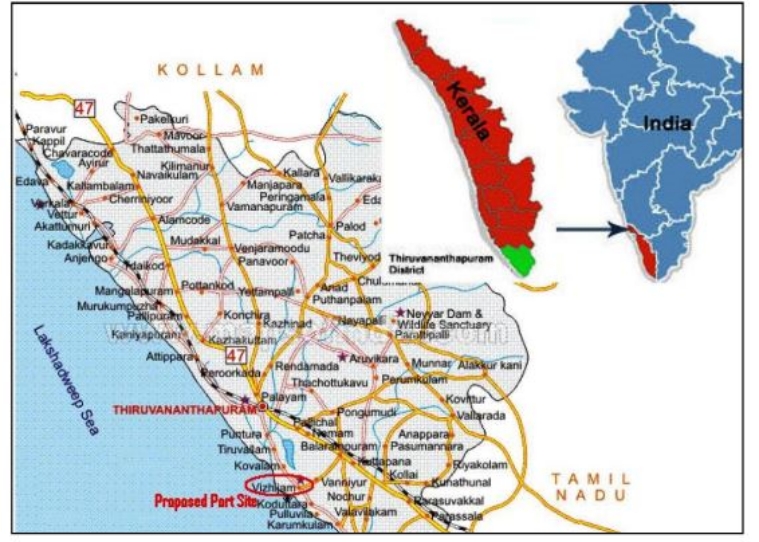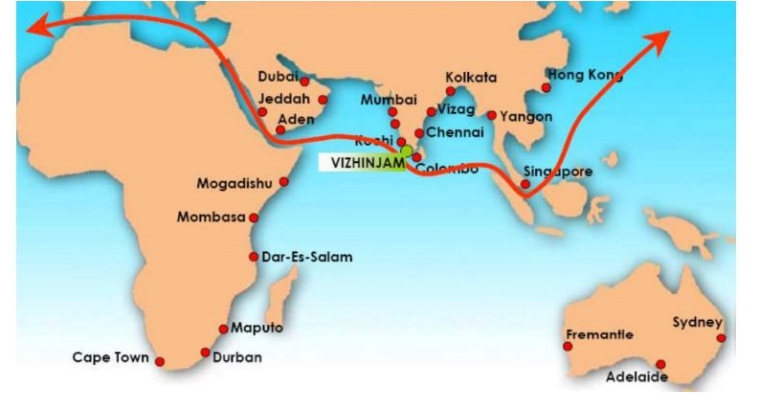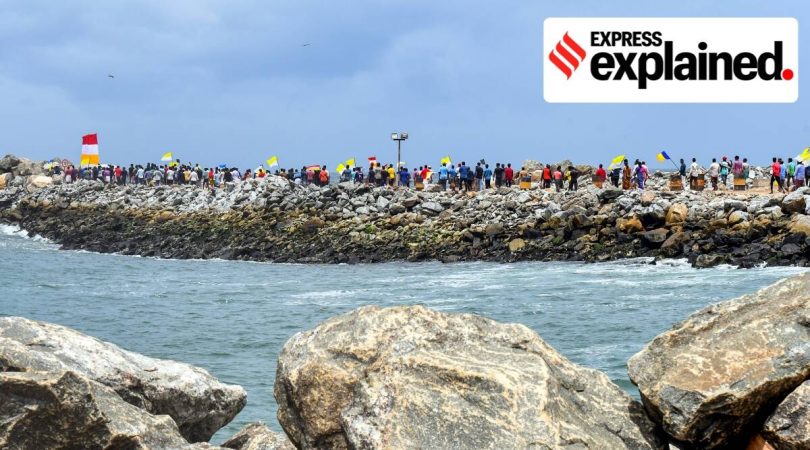[ad_1]
The week-long ongoing protests against the construction of the Adani Group’s Vizhinjam International Transhipment Deepwater Multipurpose Seaport in Kerala’s capital Thiruvananthapuram intensified on Monday (August 22), with fisherfolk laying siege to the port from the sea and land.
The fishing community under the leadership of the Catholic Archdiocese of Thiruvananthapuram has said the protests will continue until all their demands are met. At talks between Fisheries Minister V Abdurahiman and representatives of the archdiocese on August 19, the government agreed to most of the fisherfolk’s demands, but no breakthrough was achieved.
On Tuesday (August 23), Chief Minister Pinarayi Vijayan told the Assembly that the protest in some areas seemed “orchestrated”. The government, he said, was ready for talks, and wanted to resolve the concerns faced by the fishing community — however, it could not agree to halting the project.
Fisherfolk’s demands
The biggest demand of the protesters is that the construction of the Rs 7,525-crore deepwater port and container transhipment terminal at Vizhinjam on the outskirts of Thiruvananthapuram should be stopped and a proper environmental impact study should be carried out.
The community has also put forward six other demands: (i) rehabilitation of families who lost their homes to sea erosion, (ii) effective steps to mitigate coastal erosion, (iii) financial assistance to fisherfolk on days weather warnings are issued, (iv) compensation to families of those who lose their lives in fishing accidents, (v) subsidised kerosene, and (vi) a mechanism to dredge the Muthalappozhi fishing harbour in Anchuthengu in Thiruvananthapuram district.
The government has conceded all demands except providing a kerosene subsidy, and halting the construction of the port. It has agreed to find accommodation for relocated families before Onam (which begins at the end of this month).
 Vizhinjam port location. (Source: Feasibility report/Vizhinjam International seaport Ltd)
Vizhinjam port location. (Source: Feasibility report/Vizhinjam International seaport Ltd)
Community’s grievances
Rethin Pulluvila, a representative of Pulluvila ward and a member of the coastal community, said they have been raising these demands for long. “We had protested outside the secretariat, but did not get a response,” he said, adding the protests would continue until all demands were met and implemented.
A J Vijayan, a member of the Coastal Area Protection Forum who has been opposing the project from the beginning, said the protests were widening as awareness among the fishing community increased, and they experienced the impact of the project on their day-to-day life.
More than 100 families lost their homes to coastal erosion last year, but there is no official data on the relocated families except for some church records, Vijayan said. He claimed around 300 families were living in schools and camps, and many others were staying in rented accommodation or with relatives.
The fisherfolk also fear that the proximity of the port to the fishing harbour will impact the tranquillity of the sea and fishing. There are apprehensions that the proposed shipping channel will lead to loss of livelihoods.
Vijayan said that even if the church pulls out of the protest, the fisherfolk would not. “Even if they stop now, they will come back more vigorously in case of any untoward incident in the future,” he said. He also said the government may not finally implement some of the things that it concedes in discussions. “So we will stop the protest only after their offer is implemented.”
Pulluvila said that since construction began, fisherfolk have had to travel deep into the sea for catch, and this has increased fuel costs. Since the government has eliminated the subsidy on kerosene, their pockets are being directly hit.
Delays; contested studies
As per the initial agreement, the project was supposed to be operational by 2019. The Adani Group cited several reasons for the delay, from the 2017 Ockhi cyclone to the Covid-19 pandemic. The company also faced a shortage of granite boulders to build the 3.1-km breakwater, only 1 km of which has been built so far. State Minister for Ports Ahammad Devarkovil said last year that the project was now expected to be completed by 2023.
Vijayan said fisherfolk were also provoked by the central government’s annual shoreline studies that concluded work on the port did not lead to increased coastal erosion, even though the impact was clearly visible.
In 2019, the National Institute of Ocean Technology, Chennai, said in its Annual Shoreline Monitoring report that erosion spots such as Valliyathura, Shangumugham, and Punthura had remained unchanged since the construction of the port began in 2015.
The 2021 edition of the study noted erosion at Pulluvila (500 m), Mullur (290 m), Kochuveli (250 m), Punthura (150 m), Cheriyathura (120 m), Shangumugham (100m), and Valliyathura (50m), but concluded that the port activity had less impact than high wave activities and cyclones in the Arabian Sea.
Question of viability
Then Chief Minister Oommen Chandy laid the foundation stone of the Rs 7,525 crore port being built under a Public Private Partnership (PPP) model with Adani Ports Private Limited, in December 2015. The port will have 30 berths, and will be able to handle giant “megamax” container ships. The Adani Group has said the ultramodern port, located close to major international shipping routes, will boost India’s economy. The port is expected to compete with Colombo, Singapore, and Dubai for a share of trans-shipment traffic.
 Vizhinjam port location with respect to International East-West shipping route. (Source: Feasibility report/Vizhinjam International seaport Ltd)
Vizhinjam port location with respect to International East-West shipping route. (Source: Feasibility report/Vizhinjam International seaport Ltd)
The report of the Comptroller and Auditor General of India, tabled in the Kerala assembly in 2017, had said the conditions of the concession agreement were not favourable to the state government. “Out of a total project cost of Rs 7,525 crore, the Adani Group needs to invest only Rs 2,454 crore. The rest of the cost would be borne by the state and the central governments,” it had said.
The CAG had said that the standard concession period for PPP projects was 30 years, but the Vizhinjam project concessionaire had been given an extra 10 years, which would allow it to reap an additional revenue of Rs 29,127 crore.
According to Vijayan, the project would put the government in a “debt trap”, and could meet a fate similar to that of the Vallarpadam Terminal in Kochi, which has failed to make a profit more than a decade after it was opened.
[ad_2]
Source link








